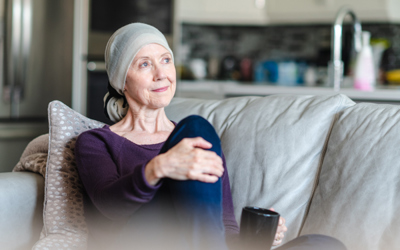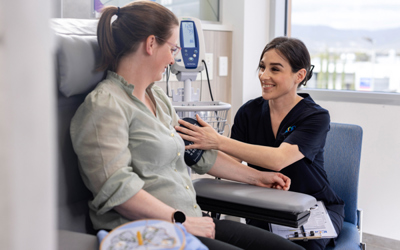What are the treatment options for chronic lymphocytic leukaemia?
The primary treatment options for chronic lymphocytic leukaemia (CLL) are immunotherapy, targeted therapies and chemotherapy. In many cases, CLL patients may never need treatment as long as you do not experience symptoms. When treatment is needed, the type of treatment you receive will depend on a number of different considerations, such as the stage of your cancer, your overall health and your treatment preferences. This page aims to give you a comprehensive overview of how chronic lymphocytic leukaemia treatment works.
Chemotherapy for chronic lymphocytic leukaemia
Chemotherapy is the primary treatment for CLL, which involves the use of a range of drugs to kill and slow the growth of chronic lymphocytic leukaemia cells. Depending on the type of CLL you have and your age, you may have different treatment options.
Common chemotherapy medicines
There are a number of different chemotherapy drugs that are used to treat chronic lymphocytic leukaemia. Some of the drugs used include:
-
Fludarabine
This treatment is in a class of chemotherapy drugs called antimetabolites. It works by interfering with the DNA production of cells, so they are unable to divide and grow. Fludarabine is delivered by intravenous infusion, with each infusion usually given over 30 minutes.
-
Cyclophosphamide and bendamustine
These belong to a class of chemotherapy drugs called alkylating agents. They work by damaging the DNA of cells so they are unable to divide, causing them to stop growing and die. They are typically delivered by intravenous infusion, with each infusion usually given over 30 to 60 minutes.
-
Cyclophosphamide
This is a chemotherapy drug that works as an alkylating agent. It is given orally as a tablet or capsule.
Chemotherapy drugs for CLL are usually given together in combination with an immunotherapy drug and administered every 28 days for six cycles.
Examples of common protocols are:
Fludarabine CYCLOPHOSPHamide Rituximab (FCR)
Bendamustine and rituximab (R-Benda)
Chlorambucil and oBINUTUZumab
Targeted therapies for chronic lymphocytic leukaemia
Targeted therapies use specialised drugs to destroy CLL cells by targeting abnormalities found within cancer cells while avoiding normal, healthy cells. Targeted therapies are the preferred treatment for people with CLL with genetic changes known as TP53 mutation or 17p deletion.
Common targeted therapy medicines
Common targeted therapy drugs used to treat chronic lymphocytic leukaemia include:
-
Venetoclax
This works by directly binding and blocking a protein called BCL-2, which is found on B lymphocytes (B cells). When this protein is blocked, it causes the cancer cells to die. It is given orally as a tablet or capsule once daily. Venetoclax is often given in combination with an immunotherapy drug such as rituximab or Obinutuzumab.
-
Acalabrutinib and ibrutinib (BTK inhibitors)
These drugs work by targeting a protein called Bruton’s tyrosine kinase (BTK) which is present in excess amounts in B lymphocytes (B cells). Since this protein is involved in controlling cell growth, targeting and blocking this protein can slow down the growth of cancer cells. Acalabrutinib is given orally as a tablet or capsule twice daily while ibrutinib is taken once daily.
-
Idelalisib
This is a kinase inhibitor that works by targeting and blocking a protein called phosphoinositide 3-kinase (PI3K) delta, which is present on B lymphocytes (B cells). When this protein is blocked, it slows down the growth of cancerous B cells. It is given orally as a tablet or capsule twice daily, usually in combination with an immunotherapy drug (rituximab).
Immunotherapy for acute lymphoblastic leukaemia
Immunotherapy trains your body’s own immune system to recognise and fight chronic lymphocytic leukaemia cells.
Monoclonal antibody drugs are a type of immunotherapy treatment which target a protein called CD20 on the surface of certain white blood cells called B-lymphocytes (B-cells). When they attach to the CD20 protein, which are present on the B cells of people with chronic lymphocytic leukaemia, this allows your own immune system to recognise and target cancer cells and destroy them.
Common monoclonal antibody drugs for CLL include:
Rituximab
Obinutuzumab
Rituximab and obinutuzumab are typically given by intravenous infusion every 28 days. In some cases, rituximab may be given as a subcutaneous injection under the skin.
Clinical trials for chronic lymphocytic leukaemia
Icon offers a wide range of clinical trials providing patients with access to new and evolving treatments. Clinical trials offer hope and opportunity and contribute to breakthroughs in treatment for future cancer patients.

Treatment by stage of chronic lymphocytic leukaemia
When you are diagnosed with CLL, your haematologist will develop your treatment plan as part of a multidisciplinary team based on the stage of your cancer. In many cases, CLL patients may never need treatment as long as they do not experience symptoms. Common treatment options for each stage of CLL include:
Stage 0 chronic lymphocytic leukaemia
While CLL is in stage 0, lymphocyte levels in your blood are high but no other symptoms of leukaemia are present. No treatment is typically need at this stage and your haematologist will likely recommend active monitoring.
Stage I chronic lymphocytic leukaemia
Stage I CLL is similar to stage 0 as lymphocyte levels are high, although lymph nodes may be larger than normal. Again, no treatment is typically needed at this stage.
Stage II chronic lymphocytic leukaemia
In stage II CLL it is also common for the liver and spleen to become swollen, alongside elevated lymphocytes in the blood and swollen lymph nodes. Depending on the severity of your symptoms and the level of lymphocytes in your blood, your haematologist may recommend that you begin treatment.
Stage III chronic lymphocytic leukaemia
Once CLL reaches stage III, lymphocytes remain elevated and your red blood cell count will have decreased, resulting in anaemia. While platelet counts will remain normal, your disease has reached an advanced and high-risk stage that now requires treatment. The first step in treatment for CLL is to lower lymphocyte levels which can be done in a number of ways. Some options include chemotherapy, targeted therapy, immunotherapy or a combination of these. Very rarely you may need leukapheresis treatment, which involves passing your blood through a machine to remove white blood cells and returning the remaining blood back to your body, as increased CLL cells in your blood stream can also cause issues with circulation.
Stage IV chronic lymphocytic leukaemia
When CLL progresses to stage IV, all previous symptoms may be present, but platelet levels will have also fallen making it difficult for blood to clot. Similarly to stage III this requires the initiation of treatment.








